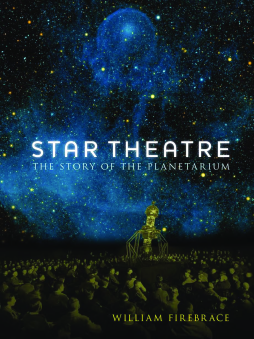
Additional Information
Book Details
Abstract
Most of us can recall a childhood visit to a planetarium: the sense of anticipation as the room darkens. The stars begin to appear as the voice of an astronomer is heard. In the planetarium, where the audience is transported to distant galaxies, the wondrous complexity of the cosmos combines with entertainment to become a theater of the night.
Star Theatre explores the history of the planetarium’s mix of science and spectacle. William Firebrace reveals how in the planetarium, the solar system and universe is demonstrated on an ever-expanding scale. He traces the origins of the building through history, from its antecedents to its invention in Germany in the 1920s, developments in the USSR and the United States, to its expansion across the globe at the time of the space race, and finally to the evolution of the contemporary planetarium in a time of startling astronomical and cosmological discoveries. This concise and well-illustrated history will appeal to astronomy lovers and those interested in architecture, theater, and cinema.
“Firebrace is at once keen dragoman, critic, poet, constantly astonished spectator, and informal reporter. His curiosity is boundless.”
— Jonathan Meades
"Star Theatre offers fascinating insights into how astronomy has, through planetariums, evolved over the past century from a tool for education and personal improvement to a crowd-pleasing public spectacle."
— Nature
"A masterful and well-researched examination of the architectural heritage and cultural significance of planetariums, such as the role of the Zeiss projector in fostering relations between Soviet-controlled East Germany and the rest of the world. It also contemplates how the development of planetariums has been influenced—indeed, challenged—by discoveries in astronomy such as black holes, gravitational waves, and the theory of dark matter, as well as the growing capabilities of projection technology. . . . Excellent images."
— BBC Sky at Night Magazine
"A well-illustrated examination of the planetarium. From its origins in static and moving models of the night sky to its current incarnation in large hemispheric domes, the planetarium has sometimes served as a temple to science and sometimes as a link to cultural values of its local community. Early models showed an earth-centered universe meant to illustrate the relative motions of the planets, sun, and moon. Star ball planetaria originated in the 1920s, using a hollow ball with a light inside to project stars and planets. More recent manifestations use computer projections and a wide range of special effects to simulate traveling through space and time. Much of the text describes how local culture affects the designs of planetarium buildings and their programming. For example, Soviet era installations differ markedly from those in the US during the early space race and Cold War. Interesting descriptions of various authors’ memories of planetarium visits, settings in films, and poetry enhance the cultural examination. Overall, Firebrace's focus is more historical and cultural than scientific, making it best suited to general readers—though a decent bibliography is included. Recommended."
— Choice
"As a historian of science who works in a major planetarium, I was frankly captivated by many of the illustrations, anecdotes, and literary and artistic references with which Firebrace adorns his account."
— Isis
William Firebrace is an architect and writer based in London.
Table of Contents
| Section Title | Page | Action | Price |
|---|---|---|---|
| Cover | Cover | ||
| Title Page | 3 | ||
| Imprint Page | 4 | ||
| Contents | 5 | ||
| Missing Planet | 7 | ||
| 1. Holy, Rough, Immediate | 11 | ||
| 2. Planetary Projection | 51 | ||
| 3. Red Star, White Star | 87 | ||
| 4. Outer Paths | 125 | ||
| 5. Visible, Invisible | 173 | ||
| Timeline of Selected Planetariums | 209 | ||
| Principal Planetariums of Architectural Interest | 213 | ||
| Further Reading | 217 | ||
| Acknowledgements | 221 | ||
| Photo Acknowledgements | 223 | ||
| Index | 225 |
